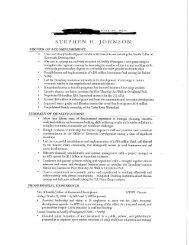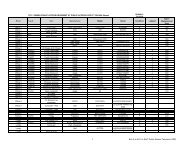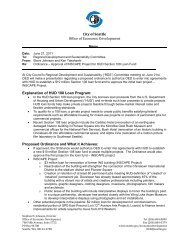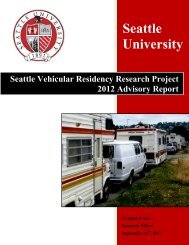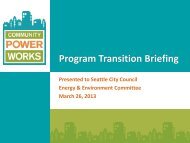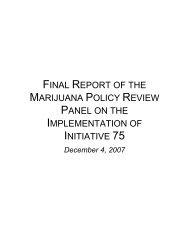2013 Water System Plan, Volume II - Seattle City Clerk's Office - City ...
2013 Water System Plan, Volume II - Seattle City Clerk's Office - City ...
2013 Water System Plan, Volume II - Seattle City Clerk's Office - City ...
You also want an ePaper? Increase the reach of your titles
YUMPU automatically turns print PDFs into web optimized ePapers that Google loves.
Chapter 5 <strong>Water</strong> Infrastructure<br />
2. Applying external bonded coatings or polyethylene film encasements (unbonded<br />
film)<br />
3. Using a cathodic protection system<br />
See DSG Chapter 6, Cathodic Protection, for detailed discussion of that protection method.<br />
5.6.8.1 Soil Resistivity<br />
Resistivity refers to the resistance of the environment to promote electrical current flow. It is<br />
the inverse unit measurement used to determine conductivity/corrosiveness of the internal or<br />
external environment in contact with the pipe surfaces. By selecting appropriate backfill (soil) or<br />
modifying chemical properties of the water being carried within the pipe, resistivity can be<br />
adjusted. When resistivity is adjusted, the corrosion rate on pipe surfaces is reduced. See DSG<br />
Chapter 6, Cathodic Protection, Tables 6-9, 6-10, and 6-11.<br />
For the soil pipe interface, adjusting soil resistivity is usually neither possible nor practical.<br />
Providing select backfill has a short-term effect. Over time, constituents in the soil surrounding<br />
the pipe will degrade the backfill and resistivity will approach that of the surrounding material.<br />
Soil corrosivity is based on resistivity measurements of the soil in the pipeline location. Typically,<br />
several measurements are taken and an average value is determined. Where soils are very near<br />
a classification break point, engineering judgment is required to classify the soil (Table 5-6).<br />
Where resistivity tests in one area vary, greater weight is given to the lower values found.<br />
Table 5-6 Corrosion Protection Requirements for <strong>Water</strong> Piping <strong>System</strong>s*<br />
Soil Resistivity (ohm/cm)<br />
0 – 900<br />
901 – 3,000<br />
3,001 – 10,000<br />
10,001 – 50,000<br />
> than 50,000<br />
Soil Corrosivity Classification<br />
Severely-corrosive<br />
Very-corrosive<br />
Moderately-corrosive<br />
Mildly-corrosive<br />
Non-corrosive<br />
*Large projects may have several soil classifications and will need to accommodate each type appropriately.<br />
Table 5-7 shows SPU requirements for water pipelines where coating is dictated by resistivity.<br />
Table 5-7 SPU Corrosion Protection Requirements for Corrosive Soil<br />
Soil Classification<br />
Severely-corrosive<br />
Very-corrosive<br />
Moderately-corrosive<br />
Mildly-corrosive<br />
Non-corrosive<br />
Notes:<br />
Corrosion Protection Requirements<br />
approved bonded coating<br />
joint bonding - #2 AWG<br />
insulating coupling or flange kit @ connections<br />
full dielectric covering on service<br />
lines to meter setter<br />
electrolysis test station<br />
class b bedding (sand)<br />
magnesium anodes @ 18’ intervals (17 lbs high potential magnesium anodes)<br />
[same as above – except anodes are spaced @ 36’ intervals]<br />
[same as above – except anodes are spaced @ 100’ intervals]<br />
- polyethylene encasement – 8 mil<br />
- class b bedding (sand)<br />
- no protection required unless organic or clay materials are encountered<br />
- additional soil tests may be required for proper recommendation<br />
SPU Design Standards and Guidelines<br />
5-37



